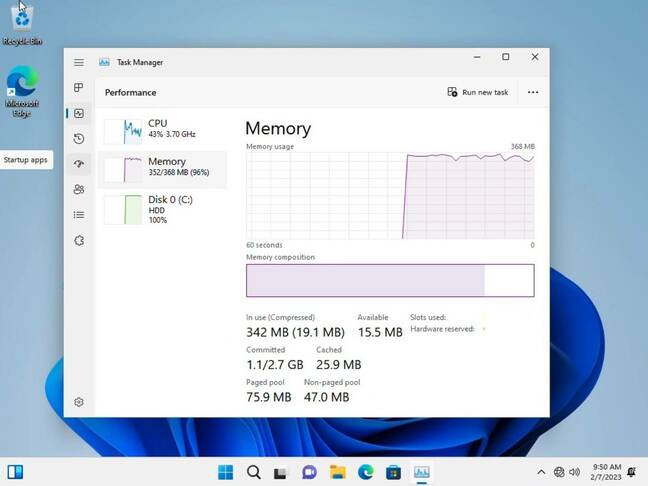This article is more than 1 year old
You can run Windows 11 on just 200MB of RAM – but should you?
Just because you can doesn’t mean you should
Video Stripping down operating systems to run on old, forgotten, or low-end hardware is nothing new, and has spawned a whole community of Linux aficionados. But what about full-fat Windows 11?
For that, Microsoft says you'll need a 1GHz processor with at least two cores, 4GB of RAM and at least 64GB of storage. Or do you? Last week, Romanian YouTuber NTDEV uploaded a stripped-down version of Windows 11 to Archive.org, appropriately named Tiny11,which you can see below.
The custom Windows edition was created by removing as many features as possible while maintaining the core user experience, NTDEV tells The Register. This included manually removing parts of the Windows Store (WinSxS).
In the video demoing the release, its creator claims the operating system can run smoothly in environments with as little as 2GB of memory – half that of Microsoft's minimum spec. However, over the weekend, NTDEV tweeted a screenshot showing the operating system running on just 384MB of RAM. "It's terribly slow, but it works," the team said.
That was quickly followed by another Twitter user posting a screenshot showing the operating system running on just 200MB of memory.
- Microsoft is changing how it handles device diagnostic data to keep EU sweet
- WINE Windows translation layer has matured like a fine... you get the picture
- Latest Windows 11 build shares desktop real estate with, er, Spotify
- Microsoft injects AI into Teams so no one will ever forget what the meeting decided
The Register spun up a stock Windows 11 VM to see how the unadulterated operating system stacks up and found that while you could technically boot off of 256MB of memory, the system wasn't what we'd call usable. While we were able to make it to the desktop, we couldn't get Task Manager to launch. And when reduced to just 200MB, the OS failed to boot properly.
It seems the minimum amount of memory required for a functional, if very slow experience is 384MB, though you'll definitely want more than that if you plan to browse the web.

In our testing, stock Windows 11 needed just 384MB of system memory to boot into a functional, if slow, desktop.. - Click to enlarge
But perhaps more important than requiring slightly less RAM than stock Windows is that Tiny11 takes up less than half the space. The stripped-down release consumes just 8GB of storage. That's down from the roughly 20GB of capacity usually required for the OS, putting into perspective just how bloated the operating system has become over the years.
If you, understandably, have reservations about downloading and installing a strange Windows ISO you found on the internet, there's nothing stopping you from creating your own.
According to NTDEV, Tiny11 was created using a combination of NTLite and MSMG to strip out unwanted features and repackage the operating system for work.
While lighter than stock Windows, NTDEV notes that the release isn't perfect. While removing the Windows Store did make the operating system considerably smaller it also means that it's not fully serviceable and cumulative updates are not possible, NTDEV explained, adding that security definitions and .NET updates still work as intended.
NTDEV says they're working on automating the process to retain the relevant parts of the Windows Store to address these challenges and make releasing future images easier. Well, that's assuming Microsoft's lawyers don't put the kibosh on this little project before then.
Still, Tiny11's creator says the image isn't intended to be used for "daily driving," but rather for those who want to try Windows 11 on older or weaker PCs or on virtual machines.
So, just because you can get Windows to run on a potato doesn't mean you should. ®
